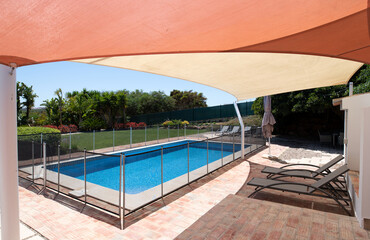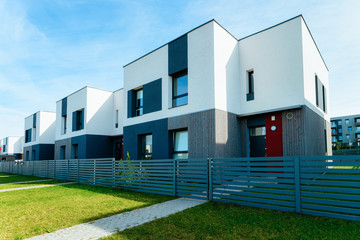While a pool fence is primarily for safety, the physical barrier it creates can also add privacy and deter children or guests from entering the pool area without your permission. A sturdy and attractive fence should resist climbing, be easy to clean, and blend in with the landscaping. It should also feature self-closing and child-proof gates.

The Centers for Disease Control and Prevention report that drowning is the second leading cause of death among children under 14. Many of these deaths occur in residential pools. Fully isolating a pool with a fence significantly reduces the risk of drowning in this age group. Pool Fences NJ is a key component of a comprehensive pool safety program and must be compliant with local and state codes.
There are several different types of pool fences to choose from, each with its own pros and cons. Wood fences offer a natural look and require regular maintenance, while vinyl fences are more affordable and low-maintenance. However, they do not provide the same privacy as a solid fence. A metal fence can be very durable and provide maximum security.
Another option is a composite fence, which offers the benefits of both wood and vinyl. These are made from recycled materials, so they are environmentally friendly and can stand up to the elements. They also have the look and feel of real wood, and can be customized to match your home’s aesthetic.
A passive infrared motion sensor can be mounted on a pool fence or wall to detect unauthorized entry into the area. When triggered, it emits a 110-decibel alarm that is audible up to 50 yards away. This is especially useful for homeowners with young children.
Fences can also be used to protect pets and other yard animals. These are great options for homeowners with small or timid dogs, as they can keep the dog from entering the pool area without an adult present. This type of fence is not as effective for older children, as it is possible for them to manipulate the gate latch.
Drowning is a rare event, so it is difficult to conduct studies that can accurately measure the impact of pool fencing on rates of drowning and near-drowning. Research designs that can evaluate the impact of pool fencing include randomized controlled trials (RCTs), case-control studies, interrupted time series designs, or cohort studies.
While the safety features of a pool fence are crucial, it’s important to remember that nothing prevents swimming accidents like proper supervision. Having a safe pool fence, however, can help to ease the mind of a nervous parent and give you one less thing to worry about.
Security
A pool fence is a physical barrier that prevents young children and pets from accidentally falling into your swimming pool. It also helps keep unwanted intruders from sneaking into your pool area. These fences are typically made of a sturdy material that is difficult to climb and cut through. They are a great addition to any residential or commercial property and provide peace of mind and safety for your guests and family members.
Drowning is the leading cause of injury and death in children under five, with many drowning incidents occurring in pools. A pool fence is a simple and effective way to help reduce the number of accidents that occur each year.
There are two types of pool fences available: permanent and removable. Permanent fences are usually made from a variety of materials and require professional installation. Removable fences, on the other hand, are made from mesh and can be easily taken down and put back up. They are generally less expensive than permanent fencing and may be a better option for homes with small children or pets.
Regardless of the type of fence you choose, it’s important to remember that no fence is completely foolproof. Even with a fence in place, you should always supervise children around your pool. Additionally, the height of your fence can make a difference in how well it protects children. The CPSC recommends that your pool fence be at least 4 ft. high.
It’s also a good idea to install passive infrared motion detectors on your fence or wall. These devices will detect a person or animal in the vicinity of your pool and immediately send off an alarm, which can be heard up to 50 yards away. This will deter rambunctious neighborhood kids from sneaking into your pool for “fun and games” and can help you protect your children.
Another safety feature to look for in your pool fence is a self-closing gate. These gates open and close automatically, so you don’t have to worry about forgetting to lock your gate before leaving the house. They also feature a latch that is difficult for children to open.
Aesthetics
If you’re worried about a pool fence ruining the look of your backyard, you should know that there are plenty of options to keep your yard looking beautiful. If you decide to go with a chain link fence, it’s important that you consider your home’s architecture and choose one that will blend in nicely. There are also removable mesh pool fences that you can store in a garage or shed when you’re not using the pool, and they come in a variety of colors to match your backyard.
You should also consider the height of your pool fence, and there are various styles to choose from. If you prefer a more natural feel, try planting bushes and trees to create a border around your pool that feels like it’s part of the natural landscape. If you have a more modern pool, consider a frameless glass fence that will add a touch of elegance to your backyard.
A concrete or aluminum fence can look sleek and modern, and it can be installed to match your existing deck. If you have a more traditional style, you can opt for a wrought iron fence that will stand out with its classic look. You can even add ornamental features to your concrete or aluminum fence to make it look more decorative.
There are also wooden fences, which can offer a more rustic touch to your backyard. If you choose to go with this option, it’s best that you invest in a quality wooden fence, because it will require more regular maintenance than other types of fencing. If you don’t want to deal with the hassle of regular maintenance, you may want to choose a vinyl fence that will be more durable and requires less maintenance.
Drownings are a serious problem, and while barriers do not guarantee that kids will not enter the pool, they do provide an extra layer of protection to ensure that kids don’t slip past parents or escape from the house unnoticed. A pool fence is a simple, cost-effective way to improve your pool safety and help reduce the number of drowning accidents in the United States every year.
Maintenance
In addition to keeping your pool safe, a well-maintained fence will add a visual charm to your yard. It will also help you keep the area around your pool clean and free of clutter and toys that could be used as climbing aids by children. This may not be the most exciting maintenance task on your to-do list, but it’s something you must do regularly to ensure that your pool fence stays in top condition.
There are some significant differences in state regulations regarding pool barrier requirements, so it’s important to double-check your specifics before committing to any repairs or improvements. While minor wear and tear can be repaired in most cases, significant damage or a full replacement of your pool fence may require the assistance of a professional and a re-evaluation by a safety inspector to ensure that it meets all the necessary criteria for safety compliance.
If you have a wood fence around your pool, regular maintenance will include sanding and repainting it as needed to maintain its beauty. This is a great option for those who enjoy the look of traditional, painted fences but want to avoid the potential for rotting or other deterioration over time. Wood can be more prone to moisture than other types of fencing materials, but by keeping up with your maintenance routine and addressing any issues as soon as they arise, you can ensure that your pool fence will stand the test of time.
Glass fencing is another great choice for those who want to avoid the potential for rusting or other structural damage to their pool fence. Unlike other types of fences, glass doesn’t rust or splinter and it is easy to clean. Using a commercial glass cleaner spray and a lint free cloth, you can simply flood the surface with your cleaning solution and scrub until it is completely clean. Afterwards, you can rinse the area with water from your hose and finish up by using a high quality glass squeegee to remove any remaining water droplets.
When it comes to caring for your glass fence, the best way to ensure its durability and continued luster is to squeegee every 10 weeks, following up with a wipe down with a damp rag and then a dry one. This will not only eliminate any buildup of dust, dirt and grime but will also help to maintain the clarity and shine of your glass fence.

